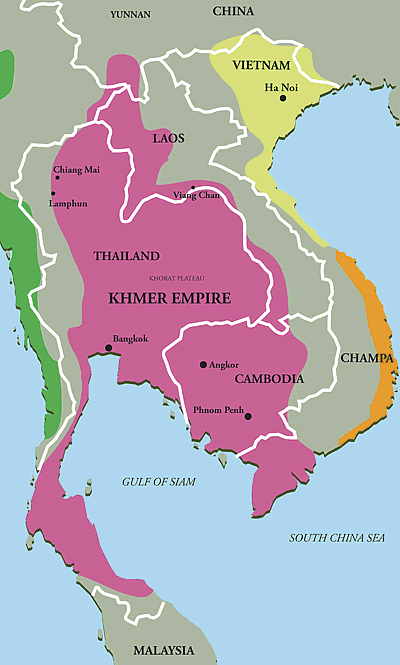The Khmer Empire
For more than 600 years, the Khmer Empire dominated Southeast Asia, ruling over much of what is now Cambodia, Laos, Thailand, and Vietnam. The Khmer Empire is known today primarily for one of its most emblematic remnants, the temple complex Angkor Wat. A man named Jayavarman II is generally thought to have been the first ruler of the Khmer Empire. In about 802, he consolidated his rule over neighboring peoples and declared himself chakravartin, or “universal ruler.&rdquo. His first capital was Mahendraparvata. Jayavarman II ruled for 33 years; his son became king on his father’s death. Such succession was common in the six centuries in which the Khmers ruled their lands; also common was the contesting of such successions by powerful warlords. The most well-known capital of the Khmer Empire was at Angkor, the original name of which was Yashodharapura, or “glory-bearing city.” The ruler Yasovarman I founded Angkor, in the late 9th Century. Many historians believe that at its largest, Angkor was the largest city in the world, rivaling the modern sprawling metropolis of Los Angeles in size. The emperor ruled over 23 provinces, which were in turn administered by a layered system of provincial and local rulers. The Khmer economy was largely agricultural, featuring large rice paddies supported by a sophisticated irrigation system that involved a network of canals and reservoirs. Orchards featured palm sugar, coconuts, and other tropical fruits and vegetables. Protein came mainly from fish but also from cattle, pigs, and poultry. Many sources say that women ran Khmer marketplaces.
Hinduism was far and away the most prevalent religion, although Buddhism made steady gains in the later years of the empire. Khmer building was extensive. Roads, bridges, and canals criss-crossed the empire, and temples dotted the landscape. Angkor Wat, begun by decree of Suryavarman II about 1122, covers 200 hectares and took 30 years to build. The Angkor Wat complex, the world’s largest religious monument, has as its main features a 213-foot-tall central tower and four surrounding smaller towers, enclosed by a number of walls. Excavations through the years have found evidence of roads, a moat, and other signs of civilization. The layout of the 162.6-hectare complex overall is, historians say, designed to match Hindu cosmology. The most common reason for the complex’s being built is that Suryavarman II wanted it to be a temple to the god Vishnu. Suryavarman II also enjoyed great success in battle, claiming ownership of the enemy Cham capital of Vijaya in 1145. Historians generally believe the Khmer Empire’s greatest king to have been Jayavarman VII. The neighboring Cham people had enjoyed great success with an invasion and had sacked Angkor Wat in 1177. Jayavarman VII’s forces liberated the temple and the Cham-held lands and turned the tables, claiming much Cham territory for the Khmers. He also ordered a large number of new building projects, among them highways, hospitals, monuments, and temples. He moved the empire’s capital to Angkor Thom, site of a large new temple complex. A large series of migrations of Thai people in the 13th and 14th Centuries accelerated the downfall of the Khmer Empire, culminating in the Ayyutthaya kingdom’s seizure of Angkor in 1431. The remnants of the Khmer people migrated, with the capital moving to Phnom Penh; the empire then faded away, absorbed by newcomers. |
|
Social Studies for Kids
copyright 2002–2025
David White



 Records of Khmer entertainment activities include stories of the people’s enjoying music, dancing, fireworks, wrestling, and horse races.
Records of Khmer entertainment activities include stories of the people’s enjoying music, dancing, fireworks, wrestling, and horse races.
